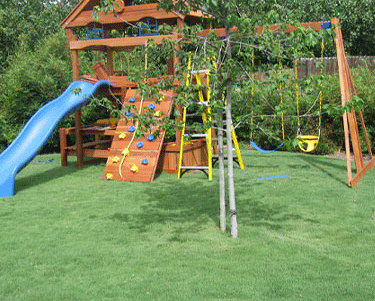Buffalograss (Buchloe dactyloidesis) is the grass of the Great Plains. It is one of the true native grasses, one that buffalo grazed on back when they roamed the plains. These days it is grown for its drought tolerance and its ability to adapt to clay soil and other tough conditions. It requires 50% less water than does bluegrass and fescue and like Kentucky bluegrass, will go into dormancy when conditions are very dry and green up after a good rain.
Buffalograss is a lawn variety that requires mowing only once per month and actually performs better if not fertilized, making it a good choice for a low maintenance landscape. It is blue-green in color and spreads primarily by above-ground shoots, called stolons. It is less aggressive than other warm season grasses and can be overtaken by the likes of St. Augustine and Bermuda grass. Excessive mechanical or foot traffic can lead to the deterioration of buffalograss. It is generally mowed to a height of 2 to 3 inches.
Is Plugging a Lawn Right for You?
Leaf Texture
Climate Zone
Buffalograss is a warm season grass that grows best in the hot, mostly arid regions of the United States, particularly in the southwestern portion of the U.S.
When to Plant
Plant in early fall, spring or early summer, when the ground is wet.
Light Requirements
Plant in full sun; buffalograss has little tolerance for shade.
Watering Requirements
All turf grasses need to be watered daily during time of establishment. Once established, periodic watering is recommended for buffalograss. An excellent way to water is with a lawn irrigation system set on a timer.
Planting Methods
Buffalograss can be successfully established by seed, however it may take 15 to 21 days, or more to germinate. Watering several times each day is required for this duration or until a good stand of grass is developed. Buffalograss can be readily established by plugs.
Soil Preparation
The best foundation for a thriving lawn is to properly prepare the soil for planting. Whether you’re planting grass from plugs or seed, the finished surface should contain at least six inches of quality topsoil, free of stones and large clumps of soil. Use a rototiller to work up the topsoil; smooth it out with a garden rake.
Planting Buffalograss Plugs
For easy planting of plugs use the ProPlugger 5-IN-1 Planting Tool. This tool will save you some serious bending over. Learn more about planting plugs using the 5-IN-1 Planting Tool.
PH and Fertilizer
Understanding the role that pH plays in the long-term health of your landscape is critical. Have your soil tested prior to planting. The 5-IN-1 is a breeze to use as a soil sampling tool. Most lawn grasses grow best in a soil with a pH of 6.0 to 6.5. If a soil test indicates a need to add lime, determine the proper amount needed and mix it in to the ground to a depth of about 4 inches. Do not fertilize buffalo grass with chemical fertilizers. A ½” layer of fine compost can be applied in the spring or fall to keep it healthy.
Insects and Disease
Be on the lookout for chinch bugs and leaf spot. Consult your local extension service for recommendations on controlling or eradicating chinch bugs and other insects. Disease problems, such as fungus, are managed mostly by good cultural practices, i.e., mowing, watering and feeding.
Buffalograss Varieties
Texoka, Sharp’s Improved, Bison, Tatanka, Cody, UC Verde (the grass of choice for coastal California and the intense heat of the lower valley of California).
What Else Does the 5-IN-1 Do?
Neil Moran is a horticulturist and author of three books on gardening. He is also the creator and author of the garden blogNorth Country Gardening.

